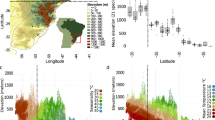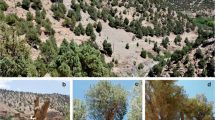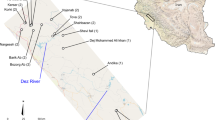Abstract
Species distribution models (SDMs), especially those basing on climatic parameters, have frequently been used to project future species ranges and to develop conservation strategies. As suggested by several authors, we considered both different dispersal abilities and different evolutionarily significant units (ESUs, as determined in an earlier genetic survey). For our study species, the flightless ground beetle Carabus irregularis, SDMs for two ESUs from the western and the Carpathian area of the distribution range showed immense, and deviating future range contractions reflecting divergent ecological requirements. As minimal dispersal SDMs resulted in a stronger decline of future ranges than the maximal dispersal models, low dispersal ability tended to strengthen the already high vulnerability of the cold-adapted mountain species to global warming. Areas shown in our maximal dispersal models as offering climatically suitable habitats for C. irregularis in the future should be considered as potential areas of action in future conservation planning (e.g. assisted migration or assisted colonisation). Thus, both dispersal scenarios and different (if applicable) ESUs should be considered when developing SDMs as useful tools for species conservation strategies adapted to species’ performance and differentiation patterns.


Similar content being viewed by others

References
Araújo MB, Guisan A (2006) Five (or so) challenges for species distribution modelling. J Biogeogr 33:1677–1688
Assmann T (1995) Zur Populationsgeschichte der Laufkäfer Carabus punctatoauratus Germar und Carabus auronitens Fabricius (Coleoptera, Carabidae): Über Endemismus in eiszeitlichen Refugialräumen und postglaziale Arealausweitung. Osnabrücker Naturwissenschaftliche Mitteilungen 20(21):225–273
Assmann T, Janssen J (1999) The effects of habitat changes on the endangered ground beetle Carabus nitens (Coleoptera: Carabidae). J Insect Conserv 3:107–116
Assmann T, Weber F (1997) On the allozyme differentiation of Carabus punctatoauratus Germar (Coleoptera, Carabidae). J Zool Syst Evol Res 35:33–43
Baselga A, Lobo JM, Svenning J-C, Aragón P, Araújo MB (2012) Dispersal ability modulates the strength of the latitudinal richness gradient in European beetles. Global Ecol Biogeogr 21(11):1106–1113. doi:10.1111/j.1466-8238.2011.00753.x
Bousquet Y (2012) Catalogue of Geadephaga (Coleoptera: Adephaga) of America, north of Mexico. ZooKeys 245:1–1722
Bousquet Y, Brezina B, Davies A, Farkac J, Smetana A (2003) Tribe Carabini Latreille, 1802. In: Löbl I, Smetana A (eds) Catalogue of Palaearctic Coleoptera, vol 1., Archostemata, MyxophagaAdephaga. Apollo Books, Stenstrup, pp 118–201
Casale A, Kryzhanovskij OL (2003) Key to the adults. In: Turin H, Penev L, Casale A (eds) The genus Carabus in Europe—a synthesis. Sofia, Pensoft, pp 73–124
Colas G (1969) Le Carabus (Chrysocarabus) punctatoauratus Germ. et ses races. Bull Soc Entomol Mulhouse 34:21–32
Crandall KA, Bininda-Emonds ORP, Mace GM, Wayne RK (2000) Considering evolutionary processes in conservation biology. Trends Ecol Evol 15(7):290–295
De Vries HH (1996) Metapopulation structure of Pterostichus lepidus and Olisthopus rotundatus on heathland in the Netherlands: the results from transplant experiments. Ann Zool Fenn 33:77–84
Desender K, Dekoninck W, Maes D (2008) Een nieuwe verspreidingsatlas van de loopkevers en zandloopkevers (Carabidae) in België. Rapporten van het Instituut voor Natuur- en Bosonderzoek 2008 Instituut voor Natuur- en Bosonderzoek, Brussel
Dieker P, Drees C, Assmann T (2011) Two high-mountain burnet moth species (Lepidoptera, Zygaenidae) react differently to the global change drivers climate and land-use. Biol Conserv 144(12):2810–2818. doi:10.1016/j.biocon.2011.07.018
Dieker P, Drees C, Schmitt T, Assmann T (2013) Low genetic diversity of a high mountain burnet moth species in the Pyrenees. Conserv Genet 14(1):231–236
Elith J, Leathwick JR (2009) Species distribution models: ecological explanation and prediction across space and time. Annu Rev Ecol Evolut Syst 40:677–697
Engler R, Guisan A (2009) MigClim: predicting plant distribution and dispersal in a changing climate. Divers Distrib 15(4):590–601. doi:10.1111/j.1472-4642.2009.00566.x
Fielding AH, Bell JF (1997) A review of methods for the assessment of prediction errors in conservation presence/absence models. Environ Conserv 24(1):38–49
Flechtner G (2000) Coleoptera (Käfer). Naturwaldreservate in Hessen 5/2.2—Niddahänge östlich Rudingshain. Zool Unters 1990–1992. Mitt. Hess. Landesforstverwaltung, Wiesbaden
Frankham R (2003) Genetics and conservation biology. C R Biol 326:22–29
Frankham R, Ballou JD, Briscoe DA (2005) Introduction to conservation genetics. 2. Auflage edn. Cambridge University Press, Cambridge
Franzen M (1995) Nachweise von Carabus irregularis Fabricius, 1792 aus Rheinland-Pfalz (Coleoptera: Carabidae). Fauna Flora Rheinl-Pfalz 8:5–15
Gebert J (2006) Die sandlaufkäfer und laufkäfer von sachsen, beiträge zur insektenfauna sachsens, Teil 1, Band 4 (Cicindelini-Loricerini). Entomologische Nachrichten und Berichte. Beiheft 10, Dresden
Gordon C, Cooper C, Senior CA, Banks H, Gregory JM, Johns TC, Mitchell JFB, Wood RA (2000) The simulation of SST, sea ice extents and ocean heat transports in a version of the Hadley Centre coupled model without flux adjustments. Clim Dyn 16:147–168
Guisan A, Thuiller W (2005) Predicting species distribution: offering more than simple habitat models. Ecol Lett 8:993–1009
Habel JC, Augenstein B, Nève G, Rödder D, Assmann T (2010) Population genetics and ecological niche modelling reveal high fragmentation and potential future extinction of the endangered relict butterfly Lycaena helle. In: Habel JC, Assmann T (eds) Relict species, phylogeography and conservation biology. Springer, Heidelberg, pp 417–439
Habel JC, Rödder D, Schmitt T, Nève G (2011) Global warming will affect the genetic diversity and uniqueness of Lycaena helle populations. Glob Change Biol 17:194–205
Hartmann M (1998) Die Verbreitung von Carabus irregularis F., C. linnei PANZER und C. sylvestris PANZER in Thürningen (Coleoptera, Carabidae). Thüringer Faunistische Abhandlungen V:147–152
Haubrich K, Schmitt T (2007) Cryptic differentiation in alpine-endemic, high-altitude butterflies reveals down-slope glacial refugia. Mol Ecol 16:3643–3658
Heikkinen RK, Luoto M, Araújo MB, Virkkala R, Thuiller W, Sykes MT (2006) Methods and uncertainties in bioclimatic envelope modelling under climate change. Prog Phys Geogr 30:751–778
Hejda R (2011) Map of distribution of Carabus irregularis in the Czech Republic. In: Zicham O (ed) Biological library—BioLib. http://www.biolib.cz/en/taxonmap/id348/
Hickling R, Roy DB, Hill JK, Fox R, Thomas CD (2006) The distributions of a wide range of taxonomic groups are expanding polewards. Clim Change Biol 12(3):450–455
Hijmans RJ, Cameron SE, Parra JL, Jones PG, Jarvis A (2005) Very high resolution interpolated climate surfaces for global land areas. Int J Climatol 25:1965–1978
Homburg K, Drees C, Gossner MM, Rakosy L, Vrezec A, Assmann T (2013) Multiple glacial refugia of the low-dispersal ground beetle Carabus irregularis: molecular data support predictions of species distribution models. PLoS One 8(4):e61185. doi:10.1371/journal.pone.0061185
IUCN (1980) World Conservation Strategy. Living resource conservation for sustainable development
Kharouba HM, McCune JL, Thuiller W, Huntley B (2012) Do ecological differences between taxonomic groups influence the relationship between species’ distributions and climate? A global meta-analysis using species distribution models. Ecography. doi:10.1111/j.1600-0587.2012.07683.x
Köhler F, Flechtner G (2007) Coleoptera (Käfer). Naturwaldreservate in Hessen 7/2.2 Hohestein. Zoologische Untersuchungen 1994–1996, Teil 2. Wiesbaden
Konvička M, Benes J, Schmitt T (2010) Ecological limits vis-à-vis changing climate: Relic Erebia butterflies in insular Sudeten mountains. In: Habel JC, Assmann T (eds) Relict species: phylogeography and conservation biology. Springer, Heidelberg, pp 341–355
Linder HP, Bykova O, Dyke J, Etienne RS, Hickler T, Kühn I, Marion G, Ohlemüller R, Schymanski SJ, Singer A (2012) Biotic modifiers, environmental modulation and species distribution models. J Biogeogr 39(12):2179–2190. doi:10.1111/j.1365-2699.2012.02705.x
Lindroth CH (1957) The faunal connections between Europe and North America. Almqvist and Wiksell and John Wiley and Sons, Stockholm and New York
Lorenz WMT (2003) Rote Liste gefährdeter Lauf- und Sandlaufkäfer (Coleoptera Carabidae s. l.) Bayerns. Schriftenreihe Bayerisches Landesamt für Umweltschutz 166:102–111
Loss SR, Terwilliger LA, Peterson AC (2011) Assisted colonization: integrating conservation strategies in the face of climate change. Biol Conserv 144(1):92–100. doi:10.1016/j.biocon.2010.11.016
Malausa JC, Drescher J (1991) The project to rescue the Italian ground beetle Chrysocarabus olympiae. Int Zoo Yearb 30:75–79
Matern A, Drees C, Desender K, Gaublomme E, Paill W, Assmann T (2009) Genetic diversity and population structure of the endangered insect species Carabus variolosus in its western distribution range: implications for conservation. Conserv Genet 10(2):391–405
Mateus CS, Almeida PR, Quintella BR, Alves MJ (2011) MtDNA markers reveal the existence of allopatric evolutionary lineages in the threatened lampreys Lampetra fluviatilis (L.) and Lampetra planeri (Bloch) in the Iberian glacial refugium. Conserv Genet 12:1061–1074
MEA (2005) Ecosystems and human well-being: biodiversity synthesis. Island Press, Washington
Moritz C (1994) Defining ‘evolutionarily significant units’ for conservation. Trends Ecol Evol 9(10):373–375
Müller-Motzfeld G, Schmidt J (in press) Rote Liste Laufkäfer (Coleoptera: Carabidae). Naturschutz und Biologische Vielfalt
Nakićenović N, Swart R (eds) (2000) Special report on emissions scenarios: a special report of working Group III of the Intergovernmental Panel on Climate Change. Cambridge University Press
Nazeri M, Jusoff K, Madani N, Mahmud AR, Bahman AR, Kumar L (2012) Predictive modeling and mapping of Malayan sun bear (Helarctos malayanus) distribution using maximum entropy. PLoS ONE 7:e48104
Parmesan C, Yohe G (2003) A globally coherent fingerprint of climate change impacts across natural systems. Nature 421:37–42
Pauli H, Gottfried M, Reiter K, Klettner C, Grabherr G (2007) Signals of range expansions and contractions of vascular plants in the high Alps: observations (1994–2004) at the GLORIA*master site Schrankogel, Tyrol, Austria. Glob Change Biol 13:147–156
Pellissier L, Pradervand J-N, Pottier J, Dubuis A, Maiorano L, Guisan A (2012) Climate-based empirical models show biased predictions of butterfly communities along environmental gradients. Ecography 35(8):684–692. doi:10.1111/j.1600-0587.2011.07047.x
Ramirez J, Jarvis A (2008) High resolution statistically downscaled future climate surfaces. International Center for Tropical Agriculture (CIAT). CGIAR Research Program on Climate Change, Agriculture and Food Security (CCAFS), Cali, Colombia
Rasplus JY, Garnier S, Meusnier S, Piry S, Mondor G, Audiot P, Cornuet J-M (2001) Setting conservation priorities: the case study of Carabus solieri (Col. Carabidae). Genet Sel Evol 33(1):141–175
Reed DH, Frankham R (2003) Correlation between fitness and genetic diversity. Conserv Biol 17(1):230–237
Reilly SB, Marks SB, Jennings WB (2012) Defining evolutionary boundaries across parapatric ecomorphs of Black Salamanders (Aneides flavipunctatus) with conservation implications. Mol Ecol 21(23):5745–5761
Rödder D, Dambach J (2010) Bioclimatic models as predictive GIS tools for the identification of potential refugia and possible migration pathways. In: Habel J, Assmann T (eds) Relict species. phylogeography and conservation biology, Springer, pp 273–284
Sachs L (1997) Angewandte Statistik: Anwendung statistischer Methoden Springer, Berlin
Schlaepfer DR, Lauenroth WK, Bradford JB (2012) Effects of ecohydrological variables on current and future ranges, local suitability patterns, and model accuracy in big sagebrush. Ecography 35(4):374–384. doi:10.1111/j.1600-0587.2011.06928.x
Schloss CA, Nunez TA, Lawler JJ (2012) Dispersal will limit ability of mammals to track climate change in the Western Hemisphere. Proc Natl Acad Sci U S A 109(22):8606–8611. doi:10.1073/pnas.1116791109
Schönswetter P, Tribsch A, Stehlik I, Niklfeld H (2004) Glacial history of high alpine Ranunculus glacialis (Ranunculaceae) in the European Alps in a comparative phylogeographical context. Biol J Linn Soc 81:183–195
Schwartz MW (2012) Using niche models with climate projections to inform conservation management decisions. Biol Conserv 155:149–156. doi:10.1016/j.biocon.2012.06.011
Schweiger O, Settele J, Kudrna O, Klotz S, Kühn I (2008) Climate change can cause spatial mismatch of trophically interacting species. Ecology 89(12):3472–3479
Schweiger O, Heikkinen RK, Harpke A, Hickler T, Klotz S, Kudrna O, Kühn I, Pöyry J, Settele J (2012) Increasing range mismatching of interacting species under global change is related to their ecological characteristics. Global Ecol Biogeogr 21(1):88–99. doi:10.1111/j.1466-8238.2010.00607.x
Schwöppe M, Kreuels M, Weber F (1998) Zur Frage der historisch oder ökologisch bedingten Begrenzung des Vorkommens einer waldbewohnenden, ungeflügelten Carabidenart: translokationsexperimente unter kontrollierten Bedingungen mit Carabus auronitens im Münsterland. Abhandlungen aus dem Landesmuseum für Naturkunde zu Münster in Westfalen 60(1):3–77
Settele J, Dover J, Dolek M, Konvicka M (2009) Butterflies of European ecosystems: impact of land-use and options for conservation management. In: Settele J, Shreeve T, Konvicka M, van Dyck H (eds) Ecology of butterflies in Europe. Cambridge University Press, Cambridge, pp 353–370
Sokolár F (1909) Carabus irregularis F. Entomologische Rundschau 1909:87–89
Svenning JC, Skov F (2004) Limited filling of the potential range in European tree species. Ecol Lett 7:565–573
Taubmann J, Theissinger K, Feldheim KA, Laube I, Graf W, Haase P, Johannesen J, Pauls SU (2011) Modelling range shifts and assessing genetic diversity distribution of the montane aquatic mayfly Ameletus inopinatus in Europe under climate change scenarios. Conserv Genet 12:503–515
Thiele HU (1977) Carabid beetles in their environments. Springer, Berlin
Turin H, Penev L, Casale A, Arndt E, Assmann T, Makarov KV, Mossakowski D, Szél G, Weber F, Turin H, Penev L, Casale A (eds) (2003) Species accounts. In: The genus Carabus in Europe—a synthesis. Pensoft Publishers and European Invertebrate Survey, Sofia, Moscow and Leiden, pp 151–283
Vigna-Taglianti A, Bonavita P, Bruschi S, Casale A, Chemini C, DeFelici S, Brandmayr P, Zetto Brandmayr T, Casale A, Vigna Taglianti A (eds) (2000) Carabus montivagus (Coleoptera, Carabidae) in the Italian Central Alps: relict or introduced by man? In: Natural history and applied ecology of carabid beetles. Pensoft, Sofia, pp 61–70
Vogler AP, DeSalle R (1994) Diagnosing units of conservation management. Conserv Biol 8:354–363
Vogler AP, Knisley CB, Glueck SB, Hill JM, DeSalle R (1993a) Using molecular and ecological data to diagnose endangered populations of the puritan tiger beetle Cicindela puritana. Mol Ecol 2:375–383
Vogler AP, DeSalle R, Assmann T, Knisley B, Schultz TD (1993b) Molecular population genetics of the endangered tiger beetle Cicindela dorsalis (Coleoptera: Cicindelidae). Ann Entomol Soc Am 86:142–152
Wachter GA, Arthofer W, Dejaco T, Rinnhofer LJ, Steiner FM, Schlick-Steiner BC (2012) Pleistocene survival on central Alpine nunataks: genetic evidence from the jumping bristletail Machilis pallida. Mol Ecol 21:4983–4995
Waltari E, Hijmans RJ, Peterson AT, Nyári AS, Perkins SL, Guralnick RP (2007) Locating pleistocene refugia: comparing phylogeographic and ecological niche model predictions. PLoS ONE 2(7):e563
Weber F (1966) Zur Verbreitung von Carabus irregularis Fabr. im Teutoburger Wald und Eggegebirge (Westfalen). Entomologische Blätter für Biologie und Systematik der Käfer (Krefeld) 62:1–5
Wilson RJ, Gutiérrez D, Gutiérrez J, Monserrat VJ (2007) An elevational shift in butterfly species richness and composition accompanying recent climate change. Glob Change Biol 13(9):1873–1887. doi:10.1111/j.1365-2486.2007.01418.x
Acknowledgments
K.H. was supported by a PhD scholarship from the German Federal Environmental Foundation (DBU; AZ 20009/055).
Author information
Authors and Affiliations
Corresponding author
Rights and permissions
About this article
Cite this article
Homburg, K., Brandt, P., Drees, C. et al. Evolutionarily significant units in a flightless ground beetle show different climate niches and high extinction risk due to climate change. J Insect Conserv 18, 781–790 (2014). https://doi.org/10.1007/s10841-014-9685-x
Received:
Accepted:
Published:
Issue Date:
DOI: https://doi.org/10.1007/s10841-014-9685-x



